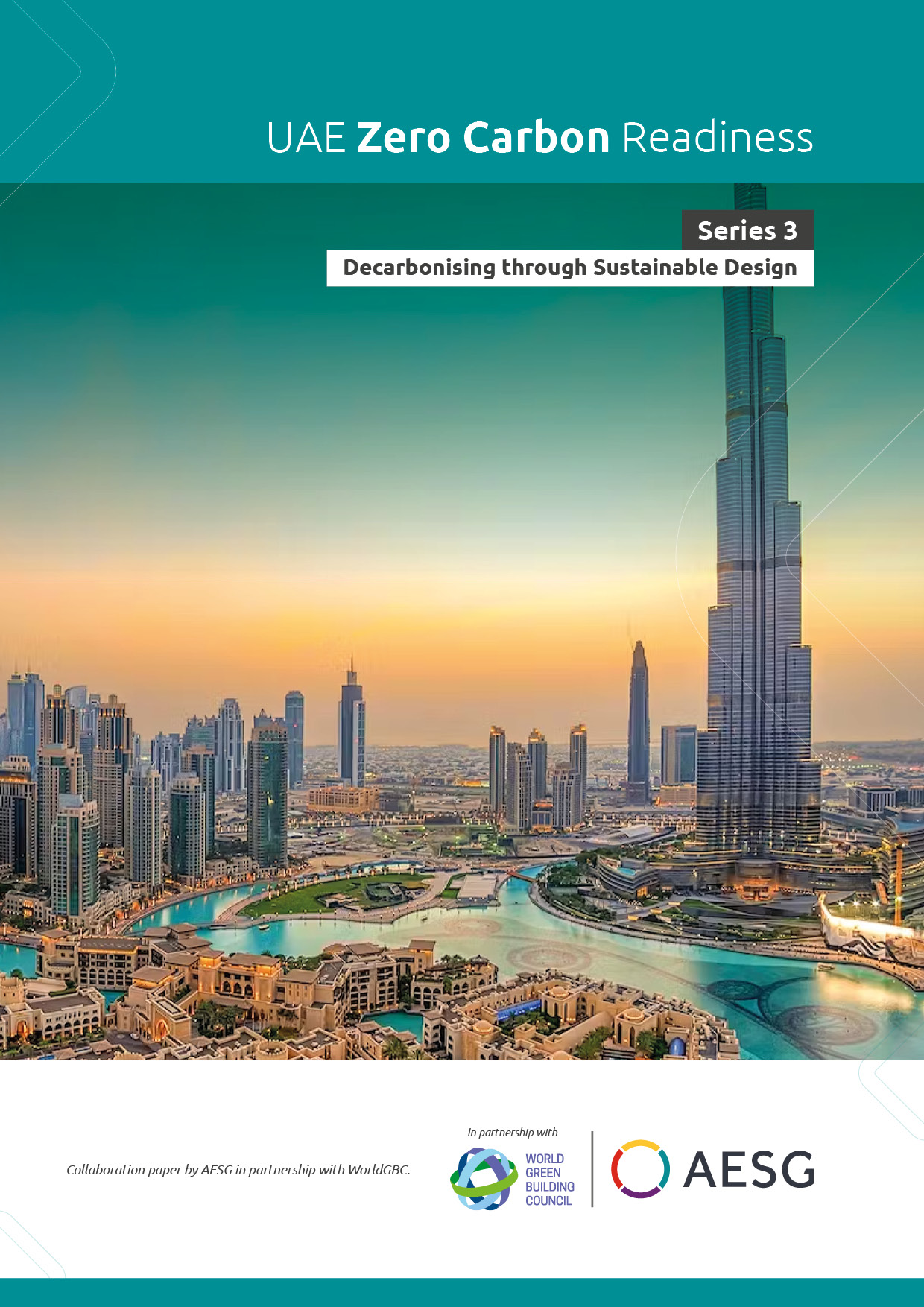
Foreword
This article has been created by AESG in collaboration with the World Green Building Council (WorldGBC) and its Middle East North Africa Regional Partners and Net Zero Collaborators through interviews and surveys from industry experts. It is the third of four articles that highlight the achievements of advancing net zero in the built environment.
This report is a result of interviews and surveys with industry experts in the UAE. We’d like to thank them for contributing to this collaborative thought leadership series:
The Progress
Sustainability is being integrated into the design practices
The UAE is embracing the visionary architectural and engineering practices, which champion energy-efficient designs seamlessly merging form and function to intricately optimise energy utilisation and significantly curtail emissions. Companies have started implementing Life Cycle Assessments (LCAs), passive design principles, harnessing the power of natural light, ventilation, Low-carbon materials, Advanced insulation systems, and more innovative technologies.
Sustainability Certifications are becoming mainstream
The UAE’s construction industry embraces globally recognised green building standards like LEED, BREAM, International Living Future Institute (ILFI) and Al Safat/Estidama. Businesses are showcasing a strong commitment by:
Top levels of certifications like LEED Platinum and Gold are becoming a common practice.
Companies are developing design guidelines, surpassing local requirements and working towards integrating sustainability in the early design practices and deployment of innovative technologies to revitalise existing buildings. By taking these measures, businesses are aligning with modern energy standards and breathing new life into the urban environment while significantly reducing emissions.
Developers are increasingly using low-carbon materials
In terms of embodied carbon, UAE developers are setting internal requirements via their procurement systems to promote low-carbon materials and equipment for key building components like steel, concrete and aluminium. Specifications for the materials are written in the construction contract, which is sent to the contractor. This leads to high embodied carbon emissions savings in some cases from 500-700 kgCO2e/m2.
The UAE’s focus on innovation in the construction sector becomes evident in the adoption of alternative techniques and using locally sourced and recyclable construction materials. Incorporating greener technologies like low-carbon concrete, steel, engineered wood, and innovative insulation materials showcases a commitment to reducing embodied carbon without compromising structural integrity. Collaboration across sectors is a key takeaway from construction decarbonisation efforts. It is crucial to engage across the value chain of construction, with architects, engineers, contractors, and material suppliers in a holistic dialogue that fosters an ecosystem of shared knowledge and best practices.
The Learnings
We need to prioritise sustainability in early design stages across project portfolios instead of focusing on showcasing projects.
Clear standards and guidelines set the stage for responsible decision-making and encourage the adoption of low-carbon practices throughout the construction projects.
Ensuring that there is a CAPEX plan and value chain stakeholder buy-in early in design stages of construction projects provides a clear roadmap for enhancing the efforts in preventing and reducing embodied carbon emissions. It also helps achieve a positive impact on OPEX from reduced consumption and operation and maintenance efforts.
The Opportunity
Low Carbon Material
The three main points that are considered a high source of carbon emissions in construction are the materials used, the construction approach, and the layout of the building.
In terms of materials used, cement and steel are considered the highest carbon emitters in the construction industry, an industry which is considered the second highest economical activity in UAE.
From a country perspective, UAE is the 2nd biggest producer of cement in GCC, 8th in the Middle East, in the top 25 globally. Despite the low population, the UAE is the leading country in the world in terms of CO2 emissions per capita for cement.
Understanding the availability of low carbon materials in the market is considered a challenge to the sustainable design practice. Companies have an increasing need to be aware of the low carbon materials options available.
The UAE has an opportunity to focus on the production of low carbon cement or steel alternatives to get on track on achieving net zero status in the construction sector.
Local manufacturing of low-carbon materials
The UAE market is driven by developers, and their interest is to keep materials economically viable. Most of the cement producers in the market are international companies from undeveloped countries which are setting a barrier to local low-carbon material manufacturing improvement.
There is an opportunity for improvement in the national regulatory framework to drive local production and support the local economy and decarbonisation. A suggestion of a starting point in this area is mandating scope 3 reporting on the developers, and improving local sourcing. It should also be looked at in terms of cost and circularity perspectives and increasing public reporting to showcase more examples in the UAE industry.
Impact Assessment of Construction Projects
Companies have started to look into Life Cycle Assessments (LCAs), but they still aren’t an everyday practice. There is an opportunity to increase the understanding of passive design and optimise energy use without the need for add on technologies. The value of Life Cycle Assessments is the opportunity to measure the impact of a project on carbon across the life cycle and enable businesses to make informed decisions on their construction practices.
Impact assessment in the early design stages is crucial to enable decisions on the project design and adoption of low-carbon technologies.
Collaboration paper by AESG in partnership with WorldGBC.
AESG is a specialist consultancy, engineering and advisory firm with regional headquarters in London, Dubai, Riyadh and Singapore. Our global footprint extends to offices also in Abu Dhabi, Al Ula, Al Madinah and South Africa, actively engaged in projects spanning across Europe, Asia, and the Middle East.
We pride ourselves as industry leaders in each of the services that we offer. We have one of the largest dedicated teams with decades of cumulative experience in sustainable design, sustainable engineering, fire and life safety, façade engineering, commissioning, digital delivery, waste management, environmental consultancy, strategy and advisory, acoustics, cost management and carbon management.

Associate Director Strategy and Advisory, AESG
Tamara is an Associate Director – Strategy and Advisory at AESG. She holds a Masters’ degree in Environmental Engineering with specialization in the fields of Energy Efficiency, GHG Emissions and Decarbonisation. Her sustainability journey in the UAE started with a 6-year engagement with Dubai Government, as part of the DSM PMO office, implementing the Energy Efficiency (DSM) Strategy in Dubai across 11 programmes and more than 10 key government sector stakeholders and private sector market players.
She has led and supported with the design and execution of key activities: DSM PMO office establishment (institutional mechanisms & procedures, organisational objectives, priorities, budget requirements), implementation of operational plans and roadmaps, DSM savings monitoring and evaluation (via data collection, modelling, top management presentations), Capacity and Awareness Programmes.
As part of the AESG Strategy & Advisory team, she has expanded her expertise to accompany government and private sector to plan and implement their Net Zero/Decarbonisation, ESG and Sustainability Journey as it evolves over time. She supports clients to understand their key Net Zero drivers, reporting requirements, following with the design of a tailored Net Zero strategies, roadmaps, action plans, timelines, budget requirements and supporting tools to successfully implement their decarbonisation initiatives and achieve Net Zero goals.
For more information or to arrange a meeting with Tamara Bajic, please email t.bajic@aesg.com